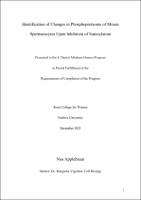Please use this identifier to cite or link to this item:
https://hdl.handle.net/20.500.12202/7893| Title: | Identification of Changes in Phosphoproteome of Mouse Spermatocytes Upon Inhibition of Sumoylation |
| Authors: | Vigodner, Margarita Applebaum, Noa |
| Keywords: | Phosphoproteome Mouse Spermatocytes Inhibition of Sumoylation |
| Issue Date: | Dec-2021 |
| Citation: | Applebaum, Noa. (2021, December), Identification of Changes in Phosphoproteome of Mouse Spermatocytes Upon Inhibition of Sumoylation, (Undergraduate Honors Thesis, Yeshiva University).. |
| Series/Report no.: | S. Daniel Abraham Honors Student Theses;December 2021 |
| Abstract: | Across the globe, approximately 15% of couples experience infertility issues with about 50% of cases primarily due to a male factor (Agarwal et al., 2021). While some causes of infertility have been attributed to the environment or genetic mutations, there are still many causes that are unknown. To create adequate infertility treatments, a better understanding of spermatogenesis and the proteins involved to promote its progression is necessary. Recent studies have identified SUMO (small ubiquitin-like modifier) proteins and have explored their role in post-translational modifications by binding to other proteins in a process known as sumoylation (Vigodner, 2011). Research suggests that through the inhibition of global sumoylation with the inhibitor Ginkgolic acid (GA), the G2/M transition was arrested in purified mouse spermatocytes in vitro (Vigonder et al., 2017). These events were determined to be regulated by the crucial kinases, PLK, Aurora kinases, and tyrosine kinases with subsequent research within the lab suggesting that sumoylation regulates several of these kinases. Over the last year and a half our lab has focussed on identifying proteins for which phosphorylation is affected when sumoylation is inhibited in spermatocytes, and regulated by the PLK, Aurora, tyrosine and any other kinases that regulate meiosis. Whether their regulation was directly or indirectly related to sumoylation, and if these targets were known to be involved in any other processes or cell types were also identified with bioinformatics analysis. While target mouse proteins were identified to be involved in both sumoylation and phosphorylation, there is still more to be known about these proteins in germ cells. Future research would focus on each protein's specific role, as well as the specified link between phosphorylation and sumoylation in regulation. Additionally, the ultimate goal would be to study these proteins and connections in vivo during mouse and human spermatogenesis. |
| Description: | Undergraduate honors thesis / Open Access |
| URI: | https://hdl.handle.net/20.500.12202/7893 |
| Appears in Collections: | S. Daniel Abraham Honors Student Theses |
Files in This Item:
| File | Description | Size | Format | |
|---|---|---|---|---|
| Noa Applebaum Honors Thesis Identification Jan2022 OA.pdf | 806.89 kB | Adobe PDF |  View/Open |
This item is licensed under a Creative Commons License

